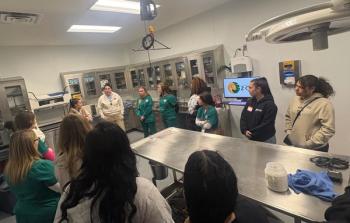
When work makes you sick
Sick over work-literally? Whether you only pick up the occasional pet mess or you're in the back treating animals every day, you need to know how to control zoonoses.
Coughing, sniffling and sneezing just might earn you a few dirty looks from coworkers who want to avoid falling ill with the creeping crud every time it sneaks into your office. And it's true that during cold and flu season, viruses and bacteria spread via indirect and direct contact and aerosol exposure such as sneezing. But in veterinary hospitals, we deal with another culprit that may occur year-round: the pathogens that can spread from our patients to us.
What's more concerning is that we're often way more lax than human hospitals when it comes to protecting ourselves from the spread of these diseases from our patients. We don't wear gloves as frequently as we should, and we've likely all witnessed a dental prophylaxis being performed with a face mask and gloves but no protective eye wear—and maybe even without the mask and gloves. Controlling zoonotic exposure in veterinary practices depends on an understanding of routes of transmission, personal protective equipment available and common zoonoses seen in the hospital. It also depends on conscientious employees with a goal of protecting themselves and others from unnecessary exposure to pathogens.
Understand routes of transmission
The first step in protecting yourself from zoonotic disease is to be aware of the three main means of transmission for various hosts: aerosol, vector-borne and contact. Aerosol transmission usually occurs through coughing and sneezing and can be generated via procedures such as suction or bronchoscopy. Vector-borne transmission can occur via vectors such as mosquitoes, fleas and ticks. Within the hospital, it's more common that we come into contact with fleas or ticks on animals that are infested. Contact may occur directly through examining, bathing or handling animals, or indirectly through contaminated items such as cages, soiled laundry or equipment.1
Start with prevention
First, it's important to understand personal protective equipment and how to avoid exposure. Consider these tips:
1. Wash your hands. Most of us have heard a million times that this is the best way to avoid not only transmission of pathogens from our patients but also from other coworkers and people from outside the workplace. But we still probably don't do it as often and as thoroughly as we should. You're protecting yourself in two different ways by thoroughly, and frequently, washing your hands: first, by the mechanical action of removing any organic material and cutting down the number of organisms left; and second, by killing and hindering the growth of flora with antimicrobial soap. Keeping fingernails short, not wearing artificial nails, wearing minimal jewelry and keeping hands moisturized can reduce the nooks bacteria can slip into and stay. The Centers for Disease Control and Prevention recommends washing for 20 seconds. Try counting next time. This is more than likely much longer than the typical rushed hand washing you observe. Alcohol-based hand rubs can work when running water isn't nearby. Apply alcohol to the palms and cover all surfaces of the hand by the mechanical action of rubbing until hands are dry.1 While not as ideal as hand washing with an antimicrobial soap, it's better than holding off altogether.
2. Wear the right clothing. Gloves, sleeves, lab coats, gowns and thick-soled, close-toed shoes are all essential in any hospital. When coming into contact with feces, broken skin such as sores or abscesses, vomit or urine, you should wear gloves.1 The biggest lapse I've seen in practice is with urine. Often, team members without gloves will collect and handle urine samples, empty urinary bags and clean urine from patients. Remember that diseases such as leptospirosis, tularemia2 and lymphocytic choriomeningitis can be spread via urine. Team members should also wear gloves during dental procedures and necropsies as well as when cleaning cages or handling lab specimens or contaminated laundry.1
Sleeves and gowns are helpful to have with patients in isolation situations, especially in cases such as those involving MRSA infection. And it's still important to thoroughly wash exposed skin underneath the gown after you carefully remove the gown. Lab coats serve as another barrier of protection, but don't rely on them as the only method of protection in these cases.
Shoes that are thick-soled, closed-toed and nonporous and easy to disinfect can help protect against bodily fluids that could penetrate. Also, this ensures that you expose one less part of the body to vectors of disease, such as ticks, and direct contact transmission through scratches or bites.
3. Use facial protection. Any procedure that may create aersolization of bacteria or spraying or splashing of bodily fluids should warrant the use of goggles or a facial shield.1 Shields can even come attached to surgical masks so you don't need to juggle both separately. These also help because they ensure you're automatically using both forms of personal protection and not forgetting one. Common procedures where you might need this protection include lancing abscesses, flushing wounds and obstetric and necropsy procedures. Bodily fluids can easily come into contact with the mucous membranes of the eyes, nose and mouth and transmit pathogens during these procedures if you don't use proper equipment.1
4. Use respiratory tract protection. Although less commonly needed, respirators that filter smaller particles, such as the N95 respirator, may be needed in suspected cases of disease, such as Mycobacterium bovis, which can cause pulmonary tuberculosis in people. Do keep in mind that when you use respirators, OSHA requires annual fit testing, training in its use and an evaluation of the health status of the user.1
Know the risks
Next, let's take a look at some of the common zoonoses in veterinary practices. Consider these threats:
> Leptospirosis. It's often transmitted to people via contact with canine urine; aerosolized urine can create droplets that can transmit disease as well. The incubation period is about seven to 12 days, and symptoms often include headache, muscle aches, fever and chills.2 To prevent exposure, always wear gloves when cleaning up accidents and collecting and handling urine samples, regardless of whether you suspect a patient is infected.
> Rabies. It's transmitted to humans via infected saliva or tissues and bites. The incubation period is about three to eight weeks, and symptoms may include headache, fever, seizures, inability to swallow and salivation.2 If possible, only vaccinated personnel should handle patients that aren't up to date on their vaccinations—and especially for those that exhibit neurologic deficits. Wear full protective gear including gloves when handling these patients and when performing necropsies on any patient, suspected or not. This creates another barrier between saliva and bites with live patients and with necropsies.
> Lymphocytic choriomeningitis. It's transmitted via saliva, urine and feces of infected mice. This of course is more of an issue in lab animal settings and exotic veterinary hospitals. The incubation period is 15 to 21 days, and it presents itself as a weaker influenza-like illness.2 Wear gloves during handling, and consider facial protection if you're disrupting urine and feces-contaminated bedding.
> Toxoplasmosis. It's probably one of the more misunderstood zoonoses. You've probably heard that the most common form of transmission in a veterinary hospital is when team members change litter boxes and come into contact with feline feces. However, toxoplasmosis is much more commonly contracted by ingestion of tissue cysts in undercooked meat.3 Thankfully, most hospitals change their litter boxes so regularly, the chances that the parasite has become infectious in that time is extremely low—it usually takes one to five days after being shed in feces.4 The incubation period is 10 to 23 days and some symptoms include myocarditis, encephalitis, sore throat and fever.2 To protect yourself in the workplace, always wear gloves when changing litter. Avoid this task altogether if you're pregnant, and make sure your hospital is regularly changing litter boxes—as you should be for the patient's sake anyway.
> Visceral larval migrans (caused by roundworms). It's transmitted via ingestion of eggs in contaminated feces. The incubation period is four to seven weeks, and signs may include fever, cough, wheezing and blindness in cases of ocular migration.2 Gloves are a must whenever dealing with suspected patients and whenever cleaning up feces from any patient, and hand washing goes a long way as a means of prevention.
> Brucellosis. It's transmitted via skin or mucous membrane contact with the bodily fluids, or tissues, of infected animals. With an incubation period of one to 15 weeks, symptoms usually include fever, sweating and myalgia.2 Depending on the procedure being performed on the animal, wearing gloves and other personal protection and washing hands thoroughly can help prevent transmission.
> Bartonellosis. Also known as cat scratch disease, it's transmitted via bites and scratches from cats. The incubation period is one to two weeks, and signs often include fever, headache and swollen lymph nodes.5 Using smart handling skills when dealing with feline patients will help prevent transmission. Remember everyone's safety, including the patient, always comes before completing a task, and educate employees about the behaviors that cats use for warnings. Wash hands immediately and thoroughly after a bite or scratch and contact a physician.
> Salmonellosis. It's transmitted via direct contact with many domestic species including dogs, cats, reptiles, rodents, fish and chickens as well as herd animals, and it's most commonly seen with turtles. The incubation period is six hours to three days, and signs may include diarrhea, headache and fever.2 Washing hands very well, especially before eating a meal and after handling an animal—in particular turtles, chicks and ducklings in exotic hospitals—will help with prevention.
> Cryptosporidiosis. It's transmitted via ingestion of oocysts in contaminated feces. It has an incubation period of two to 10 days, and signs often include stomach cramps, dehydration and nausea. These oocysts more readily infect humans when transmitted from livestock. Feline and canine infections are a bigger danger for immunocompromised individuals.6 Wearing gloves and washing hands aid most in prevention, and immunocompromised individuals should avoid contact altogether if at all possible.
Protect your team
These are only a handful of the zoonoses you may come into contact with while working in a veterinary hospital. And hand washing and wearing gloves protect employees more than any other method of personal protection. Facial protection and respiratory tract protection are still useful, and it's important to be prepared in advance to use them during certain procedures.
Although it's important to familiarize yourself with common zoonoses, it's best to make the decision about how you protect yourself by the procedure you're performing and how you'll be exposed to bodily fluids, vectors of disease or bites and scratches instead of the suspected pathological condition in a patient. It's always best to treat any bodily fluid or any scratch or bite as one from an infected animal and prepare before contamination occurs. It's easy to lapse in these practices of personal protection on busy days, but remember this: Your patients and coworkers need you in the best possible health so you're ready to offer the best care for the patients at your practice.
Oriana Scislowicz, BS, LVT, VDT, is a technician in Richmond, Va. Send comments to
References
1. Compendium of Veterinary Standard Precautions for Zoonotic Disease Prevention in Veterinary Personnel. National Association of State Public Health Veterinarians. Available at:
2. Zoonotic Diseases Fact Sheet. American Biological Safety Association. Alliance: OSHA Cooperative Program. Web. Available at:
3. Pregnancy and Toxoplasmosis. The Humane Society of the United States. Available at
4. Toxoplasmosis. DPDx: Laboratory Identification of Parasites of Public Health Concern. Centers for Disease Control and Prevention. Available at:
5. Cat Scratch Disease. CDC. Centers for Disease Control and Prevention. Available at:
6. Cryptosporidium. CDC. Centers for Disease Control and Prevention. Available at:
Newsletter
From exam room tips to practice management insights, get trusted veterinary news delivered straight to your inbox—subscribe to dvm360.






